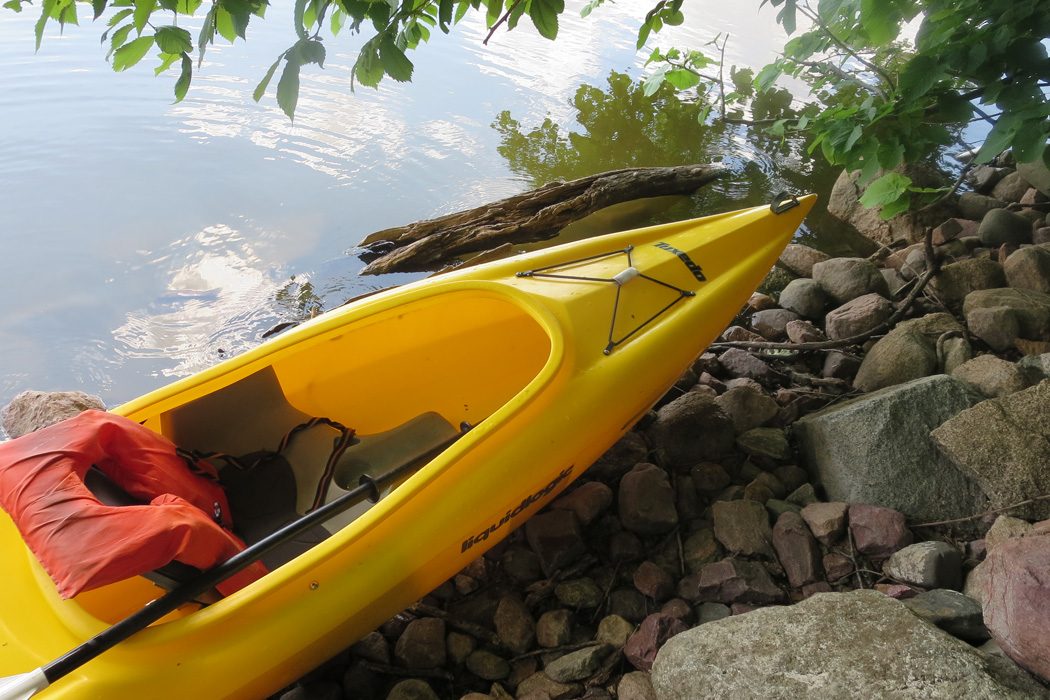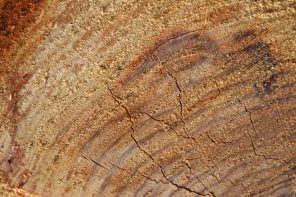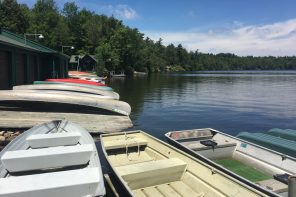As I dip my paddle into the still water and pull, the kayak slides forward in a fluid motion across the vibrant blue surface of the lake. Dip, pull. Lift, turn. Dip, pull. Sunlight rains down between a few scattered clouds, and not even a breath of wind sweeps across the water. Completely alone on the lake, I head toward the island. The journey takes only a few moments and soon my plastic yellow boat is bumping against the stony shoreline of the wooded island resting in the southern portion of the lake, not far from the eastern edge. I throw my leg over the side and hop into the water to pull the kayak up out of the lake and onto the rocks. Barefoot, I head up the hill into my sanctuary. The island is bathed in perfect silence on this still, summer afternoon. Hidden among the trees, I walk gingerly through the underbrush, the holy ground. I feel like Eve walking in the Garden of Eden, as if I am the only person on Earth. To me, the island has always felt like a thin space—a place where the holy breaks into the ordinary. Eden is just one such mythic space, a garden symbolizing the Christian beliefs about new life and beginnings.
Nearly all societies possess the idea of mythic space, a place where life originated. Humans orient themselves in relation to their mythic space to define their place in the world. In this cosmological cartography, we seem to always place our home, our place of sacred well-being, at the center of the world. Nearly all early maps are oriented in this way—society at the center, surrounded by the cardinal directions. Medieval Christians created T-O maps which placed Jerusalem, the Holy Land in the center and Paradise, in the far east, at the top. The outer ring of the map symbolized the sea, and the T-shape in the center was formed by the sacred rivers. The rivers divided the remaining land into three continents, Europe to the north, Africa to the south, and Asia in the east.
Maps originating from societies in Asia and North America follow a similar method, centering their homeland in the map and placing lesser known regions farther from the middle, pushing outward toward an ocean on all sides. Home is always island on these maps; water fills the gaps in knowledge and the unknown places. Finding the center, a home ground from which to orient the known world is a basic human need. Whether consciously or not, we are a collective of spiritual wayfarers searching for our mythic space—the place from which we derive meaning for our lives.
The Ioways, who inhabited northwest Iowa prior to the Dakota, revered islands in their understanding of creation. The Ioways worshiped the Great Spirit who created all things. In the beginning, the earth was flat and surrounded by water on all sides; all people lived together on the island at the heart of the world. As time passed, they left the island to seek further sustenance and resources, dividing themselves into tribes and traveling across the water. The island where people originated was believed to be in the far east, and the people traveled away by swimming or paddling skin boats. When the Ioways left the island, they stopped on a sandbar at the headwaters of a large river and a strong wind blew dust on them. In their own language, the Ioways call themselves Baxoje, which means gray snow or dust noses; translation into French obscured its meaning. From these headwaters, the tribe spread farther throughout the Midwest and reached Iowa on their journey westward.
Emergence stories are common among indigenous groups who trace their ancestry back to a physical location which takes on mythical properties. When generations of people continue to inhabit or to return to the same area, home takes on an ancestral heritage. Even tribes who migrated with the changing seasons felt a strong affinity for particular locations. Scholar Yi-Fu Tuan described the attachment of migratory tribes to certain places. He wrote that strong emotional ties are established with “the home of ancestors, the dreaming place where every incident in legend and myth is firmly fixed in some unchanging aspect of nature—rocks, hills and mountains, even trees.” In this place, the “estate” as he calls it, continuity is established by cultural memory and the proper veneration of the deceased.
Here at Ingham, unverified rumors circulate the story that the island is a sacred Native American burial site reserved for chiefs and their wives. While no official information regarding the presence of such graves exists, arrowheads and pieces of ceremonial stones have been found on the island. The private collections of local historians provide evidence that Woodland era inhabitants used the area extensively, and written accounts also confirm that Crow, Ioway, Blackfoot, Dakota tribes all resided in northwest Iowa. A long tradition of settlement in this sheltered, resource-rich area surely affirms its long history as a homeland. Regardless of whether the natural features of the island inspired Native Americans to use it as a burial site for honored leaders, the island’s isolation captured the imagination of Thomas Mahar, one of the first settlers of the Ingham area, who homesteaded over one hundred years before it received that name. His story, as shared with Sylvester Berge, confirms the island as a burial site, revered in one family’s understanding of home.
In 1976, Sylvester Berge shared Mahar’s story with the Estherville Daily News. After the deaths of his mother, wife, and child, whom he most likely lost to influenza, Thomas Mahar chose the island to serve as their burial site. Unmarked and obscured by time, their graves lie on a ridge on the northern tip of the island, a place Mahar must have hoped would remain undisturbed. Reporter Randy Tindall re-imagined the scene quite beautifully:
When he carried his burden through the water to the island…he must have rejoiced in the quiet scene overlooking the still wild lake. When he buried his wife and child on the bluff on the west side of the island, he may have stood sadly with the breeze from the lake blowing across his face, taking comfort, at least, in the fact that his family would rest undisturbed through the years. There were no cemeteries then, only isolation and beauty.
Tindall also described Berge, an amateur archeologist, as a man who “search[ed] the island for the remains of other wandering spirits, those of Indians who held the land before Tom Mahar was ever born.” This brief newspaper article captures the island as a symbol of both grief and beauty—a simplistic, cloistered cemetery which a mourning man hoped would shelter the resting place of his beloved family. The island became a place he could return to feel close to them while he grieved their absence, and perhaps the line between the physical and spiritual blurred just slightly.
When I visit the island, I attend to a different spiritual presence. Like the Ioways, I identify the island as the center of my own mythic reality. My spiritual universe is oriented here because the Great Spirit, this supernatural being I call God, used this place to reveal himself to me. I regard the island as my own Eden, a place of harmonious relationship with Creator and creation. I listen for the footsteps of God wandering this small grove, and I’ve heard them. This tantalizing closeness to God stirs my love for this place and causes me to regard it as a home, a place of life-giving vitality and spiritual well-being. The island is the center point on my compass. Yuan also writes that “in the mythical space of traditional societies the idea of center or ‘middle place’ is important. The idea of a center or heartland is also important to American space.” It feels perfectly fitting to ascribe myself to this cultural schema. My island becomes an ultimate center, surrounded by water, situated in the center of a county in a state which in the center of the country. Making this point requires certain approximations, but centering myself on this place follows the long map-making tradition. If Ingham Lake were a T-O map, the island would rest slightly off center, in the east, just like Eden.
The diverse pursuits of humanity are centered on many places, people, and ideals, but I tend to believe that beneath the particularities, all our searching leads back to the same island, the one center of existence that the Ioways envisioned. There, at the heart of the world, is a universal, life-giving, and all-consuming love. The transcendent, ultimate reality which mystical experiences only hint at is fully realized in this interior Holy of Holies, and places like my island in Ingham Lake are the passages to the ultimate mythic space.




